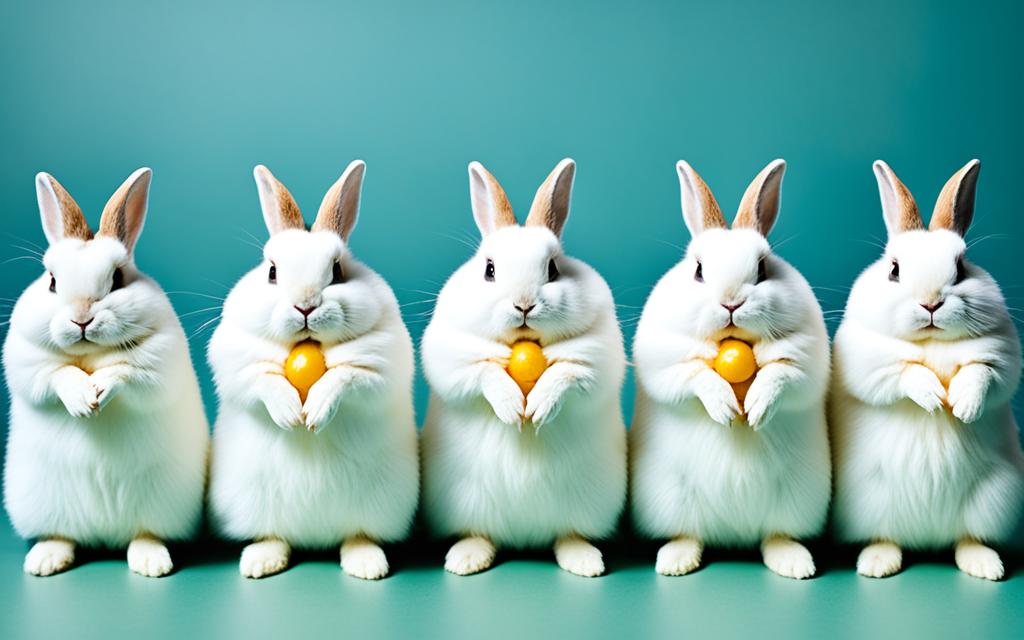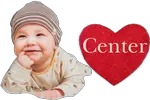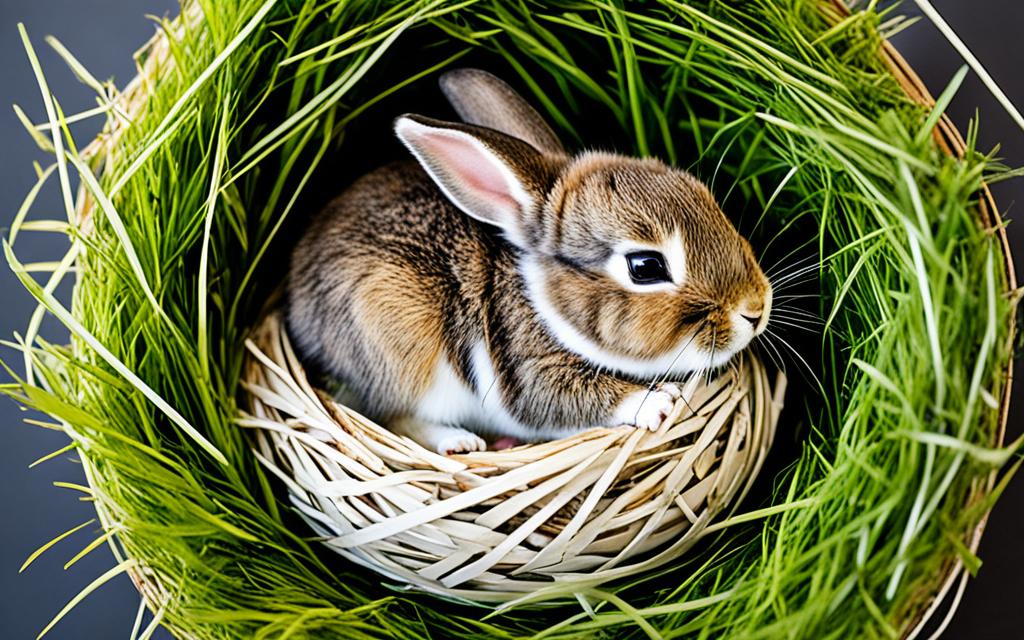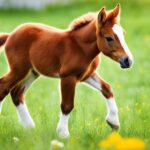Welcome to our comprehensive guide on how to determine the age of a baby rabbit. As an attentive rabbit owner, understanding a baby rabbit’s age is essential for providing appropriate care and ensuring its healthy growth. In this article, we will explore various methods and techniques used for rabbit age determination.
Whether you’re a new rabbit owner or have stumbled upon a baby rabbit in the wild, being able to estimate its age can provide valuable insights into its development and specific care requirements. By observing visual cues, examining teeth and ears, considering weight and size, and recognizing developmental milestones, you can make an educated guess about a baby rabbit’s age.
Ready to embark on this age-determining journey? Let’s dive in and uncover the secrets behind deciphering the age of a baby rabbit.
Key Takeaways:
- Understanding a baby rabbit’s age is crucial for appropriate care and healthy growth.
- Visual cues, teeth and ears development, weight and size, and developmental milestones can provide valuable insights into a baby rabbit’s age.
- Seeking expert opinions and documenting the rabbit’s history are essential for accurate age determination.
- Avoid common mistakes when estimating a rabbit’s age to ensure accuracy.
- Determining a baby rabbit’s age helps in providing the best care for their healthy growth and development.
Visual Cues for Rabbit Age Identification
Visual cues can provide valuable insights into a baby rabbit’s age. By observing physical characteristics and growth milestones, you can estimate the age of a young rabbit. These cues help you understand a baby rabbit’s approximate age and ensure appropriate care for their healthy growth.
When determining a baby bunny’s age, consider the following visual cues:
- Fur: The condition and appearance of a rabbit’s fur can indicate their age. Newborn rabbits typically have sparse and fine fur, while older bunnies have denser, longer, and more developed fur.
- Eyes: The development of a rabbit’s eyes is an essential milestone for age assessment. Baby rabbits are born with closed eyes, which gradually open within their first seven to ten days of life. As they mature, their eyes become brighter and more alert.
- Body Proportions: Observing the proportions of a baby rabbit’s body can provide clues about their age. Newborns have disproportionately large heads and small bodies, while older rabbits have more balanced proportions as they grow.
By paying attention to these visual cues, you can make a preliminary estimation of a baby rabbit’s age. However, keep in mind that individual variations and growth rates can affect the accuracy of age determination.
The adorable image above showcases the visual cues discussed in this section. Take a closer look and compare it to the characteristics of the baby rabbits you are trying to identify the age of.
Growth Milestones
Along with visual cues, identifying growth milestones is another effective way to estimate a baby rabbit’s age. By monitoring their development, you can gain further insights. Here are some important rabbit growth milestones for age assessment:
| Age (in weeks) | Growth Milestone |
|---|---|
| 1 | Birth |
| 2-3 | Eyes open, starting to nibble on solid food |
| 4-5 | Active hopping, increased independence |
| 6-7 | Weaning off mother’s milk, fully mobile |
Keep in mind that these growth milestones are general guidelines, and individual baby rabbits may achieve them at slightly different times. A combination of visual cues and growth milestones provides a more comprehensive approach to rabbit age identification.
Teeth and Ears Development
The development of a rabbit’s teeth and ears can provide valuable insights into their age. As baby rabbits grow, their teeth go through distinct stages of development, and their ears undergo changes that can help determine their approximate age.
Growth Patterns of Baby Rabbit Teeth
The teeth of a baby rabbit play a significant role in age estimation. When rabbits are born, they have tiny milk teeth that are not fully developed. Over time, these milk teeth are gradually replaced by permanent adult teeth. By examining the growth patterns and condition of the teeth, you can gain insights into a baby rabbit’s age.
Here are some key indicators to look out for:
- Tooth Length: Baby rabbits have shorter teeth compared to older rabbits. As they age, their teeth gradually lengthen and become more prominent.
- Tooth Color: Baby rabbit teeth are typically lighter in color compared to adult teeth, which tend to be more yellowish. The color change occurs as the baby teeth are replaced by the permanent ones.
Changes in Rabbit Ears as They Age
Observing the changes in a rabbit’s ears can also provide clues about their age. Baby rabbits have smaller and less developed ears, which undergo distinct transformations as they grow.
Here are some ear-related age indicators:
- Ear Size: Baby rabbits have relatively small ears in proportion to their head size. As they mature, their ears gradually grow larger and become more prominent.
- Ear Mobility: Younger rabbits may have less control over their ear movement compared to older rabbits. As they age, their ability to move and adjust their ears becomes more refined.
The combined analysis of teeth and ears development can help provide a more accurate estimation of a baby rabbit’s age. By observing these indicators, you can gain valuable insights into their growth stage and ensure their appropriate care and development.
Note: The image above showcases the development of a young rabbit’s teeth and ears, which can be essential in estimating their age.
Weight and Size Considerations
When it comes to determining the age of a baby rabbit, weight and size play a crucial role. By understanding the average weight and size of rabbits at different stages of development, you can make a more accurate estimate of their age.
Here’s a rundown of the typical weight and size milestones for rabbits:
| Age | Average Weight | Average Size |
|---|---|---|
| Newborn | 25-45 grams | Tiny and fragile |
| 1 week | 75-125 grams | Can fit in the palm of your hand |
| 2 weeks | 150-250 grams | Slightly bigger with more noticeable fur |
| 3 weeks | 250-350 grams | Optimal time for weaning |
| 4 weeks | 300-450 grams | Active and exploring their surroundings |
| 5 weeks | 400-600 grams | Well-coordinated and agile |
| 6 weeks | 500-800 grams | Close to adult size |
Remember, these weight and size ranges are average measurements, and individual rabbits may vary. By comparing the weight and size of a baby rabbit to this bunny age chart, you can gain a better understanding of their development and estimate their age with greater accuracy.
Next, we’ll explore the developmental milestones that rabbits typically achieve at different ages, shedding further light on how to determine a baby rabbit’s age.
Developmental Milestones
Baby rabbits, like any other animals, go through various developmental milestones. These milestones can give you valuable insights into their growth and help you determine their approximate age. Here are some key milestones that rabbits typically achieve at different stages of their development:
1. Hopping and Mobility
At around 2 to 3 weeks old, baby rabbits start to develop their hopping abilities. Initially, their movements may be clumsy and uncoordinated, but over time, they become more agile and capable of hopping longer distances.
2. Opening Eyes
Newborn rabbits are born with closed eyes, but they usually begin to open their eyes when they are about 10 to 14 days old. By this stage, their vision becomes clearer, allowing them to explore their surroundings.
3. Ear Erectness
Around 10 to 14 days old, the ears of baby rabbits start to become more erect. Initially, their ears may be floppy, but as they grow, the cartilage in their ears stiffens, resulting in fully upright ears.
4. Eating Solid Food
Around 3 weeks old, baby rabbits begin to nibble on solid food, in addition to their mother’s milk. This milestone marks the start of their transition from a purely milk-based diet to a more varied and solid diet.
5. Exploring the Environment
As they grow older, baby rabbits become more curious and adventurous. At around 4 to 5 weeks old, they start exploring their environment beyond the confines of their nest, venturing out to discover their surroundings.
6. Sexual Maturity
Rabbits reach sexual maturity at different ages depending on their breed. Generally, rabbits reach sexual maturity between 3 to 6 months old. This milestone indicates their readiness for breeding and reproduction.
Understanding these developmental milestones can assist you in estimating the age of a baby rabbit. However, it’s important to note that individual rabbits may reach these milestones at slightly different times. To get a more accurate assessment of a rabbit’s age, it’s best to consider multiple factors and consult with a veterinarian or experienced rabbit breeder.

Interaction and Behavior Analysis
Analyzing a baby rabbit’s behavior and interaction patterns can also provide clues about its age. By observing their behavior, you can make an educated guess about a baby rabbit’s age. Here are some key behaviors and social interactions commonly observed in rabbits at various stages of development:
1. Exploration and Curiosity
Young rabbits are naturally curious and tend to explore their surroundings. They may sniff and investigate objects, corners, and crevices, displaying a playful and inquisitive nature.
2. Bonding and Socialization
Rabbits are social animals and seek companionship. Baby rabbits will often engage in bonding behaviors with their littermates, such as grooming, chasing, and gentle nibbling. They may also exhibit signs of seeking human interaction and enjoy being petted and held.
3. Eating Habits
The eating habits of baby rabbits can provide insights into their age. As they grow, they transition from a diet consisting primarily of their mother’s milk to solid foods. Observing their feeding behaviors and the types of foods they consume can give you an idea of their age.
4. Playfulness and Energy Levels
Baby rabbits are known for their playful nature and boundless energy. They engage in activities such as hopping, binkying (leaping into the air with a twist), and running in circles. Their level of activity and enthusiasm can vary depending on their age and overall health.
5. Litter Box Training
As baby rabbits mature, they begin to exhibit natural litter box instincts. They may start showing interest in using a designated area for urination and defecation. Litter box training is a developmental milestone that typically occurs around 4 to 6 weeks of age.
By closely observing these behaviors and interactions, you can gain valuable insights into a baby rabbit’s age and developmental stage. However, it’s essential to remember that individual rabbits may exhibit variations in behavior, so these observations should be used as a general guide rather than a definitive age determination method.
| Behavior | Age Range |
|---|---|
| Exploration and Curiosity | Newborn – 2 weeks |
| Bonding and Socialization | 2 – 4 weeks |
| Eating Habits | 2 – 4 weeks |
| Playfulness and Energy Levels | 4 – 8 weeks |
| Litter Box Training | 4 – 6 weeks |
Expert Opinions and Resources
When it comes to determining the age of a baby rabbit, seeking expert opinions and consulting reliable resources can be immensely helpful. Whether you’re a new rabbit owner or an experienced enthusiast, gathering insights from knowledgeable professionals can provide valuable guidance in accurately estimating a rabbit’s age.
One excellent resource to consider is experienced rabbit breeders in your local area. These breeders have extensive knowledge and hands-on experience with rabbits of different ages. They can offer valuable insights into the growth patterns, physical characteristics, and developmental milestones of baby rabbits. Additionally, they may be able to provide guidance on specific breeds and their typical growth trajectories, allowing you to make a more accurate assessment of a baby rabbit’s age.
Another essential resource for determining a baby rabbit’s age is your local veterinarian. Vets specializing in small animals, including rabbits, possess the knowledge and expertise to assess a rabbit’s age based on physical examination and developmental milestones. They can also provide general guidance on rabbit care and offer personalized advice based on your rabbit’s specific needs.
On top of seeking expert opinions, the internet is a treasure trove of resources for rabbit age determination. Online rabbit communities and forums dedicated to rabbit care and breeding can provide valuable insights and experiences shared by rabbit owners and enthusiasts. You can find helpful discussions, articles, and even step-by-step guides on how to assess a baby rabbit’s age. However, exercise caution when relying on online sources and ensure that the information comes from reputable websites and experienced rabbit breeders or veterinarians.
Remember, determining a baby rabbit’s age requires a combination of knowledge, experience, and careful observation. Do not hesitate to reach out to experts and consult reliable resources to ensure accuracy in your assessment. By leveraging expert opinions and credible resources, you can confidently determine a baby rabbit’s age and provide the best care for their specific developmental needs.
Documenting the Rabbit’s History
When it comes to determining the age of a baby rabbit, documenting its history is key. By keeping comprehensive records of important information such as birth dates, acquisition dates, and previous owner information, you can gain valuable insights into the rabbit’s age and background.
Imagine the Rabbit’s History as a Puzzle
The rabbit’s history is like a puzzle that reveals its age. Each piece of information fits together to form a clearer picture of the rabbit’s past. Just like a detective, you must gather all the clues to unlock the mystery of the rabbit’s age.
The Importance of Birth Dates
Knowing the rabbit’s birth date is crucial for accurately determining its age. If you have the privilege of knowing the exact date, you can calculate the age in days, weeks, or months, depending on the rabbit’s age. Keep in mind that baby rabbits grow rapidly, so even a difference of a few days can significantly impact their age.
Acquisition Dates and Previous Owner Information
Another important piece of information to document is the rabbit’s acquisition date and any details about previous owners. If you know when the rabbit was obtained and have contact information for previous owners, you can trace its history and potentially gain additional insights into its age.
A Complete Picture
By gathering birth dates, acquisition dates, and previous owner information, you can create a more complete picture of a baby rabbit’s history. This information, combined with visual cues, developmental milestones, and behavior analysis, will allow you to make a more accurate determination of the rabbit’s age.
| Documenting the Rabbit’s History: Key Information | |
|---|---|
| Birth Date | Acquisition Date |
| Previous Owner Information |

Common Mistakes to Avoid
When it comes to determining the age of a baby rabbit, there are several common mistakes that inexperienced rabbit owners often make. These errors can lead to inaccurate age estimations and potentially impact the care and well-being of the young rabbit. To help you avoid these pitfalls, here are some key things to keep in mind:
1. Relying Solely on Visual Cues
While visual cues like fur, eyes, and body proportions can provide some insights into a baby rabbit’s age, it is important not to rely solely on these characteristics. They can be subjective and easily influenced by factors such as breed and individual variation. Instead, consider a holistic approach that combines visual cues with other methods for more accuracy.
2. Neglecting Teeth and Ears Development
The growth patterns of a rabbit’s teeth and ears can be valuable age indicators, but they should not be the sole basis for age determination. Teeth and ear development can vary within the same age group, so it’s essential to consider them in conjunction with other factors to make a more accurate estimation.
3. Ignoring Weight and Size Considerations
While weight and size can provide insights into a baby rabbit’s age, it’s crucial to understand that individual growth rates can differ. Comparing a rabbit’s weight and size to general benchmarks is helpful, but it should be considered alongside other methods to avoid erroneous conclusions.
4. Overlooking Developmental Milestones
Developmental milestones, such as hopping, eating solid food, and behavior changes, are important indicators of a baby rabbit’s age. However, it is essential to note that these milestones can vary depending on the individual and environmental factors. Use these milestones as a reference but always consider other age-determining techniques.
5. Failing to Seek Expert Opinions
One of the common mistakes is not seeking advice from experienced rabbit breeders, veterinarians, or online resources. These professionals and resources can provide valuable insights and guidance, ensuring a more accurate age determination. Be open to learning from experts to avoid making misguided assumptions.
6. Disregarding the Rabbit’s History
Documenting a baby rabbit’s history, such as birth dates, acquisition dates, and previous owner information, is crucial for estimating its age. Neglecting to gather these details can lead to inaccurate age estimations. Keep proper records and consider them alongside other age-determining methods.
By avoiding these common mistakes, you can improve your accuracy in determining a baby rabbit’s age. Remember, it’s essential to use a combination of methods, seek expert advice, and consider the individual characteristics of the rabbit. With patience and careful observation, you’ll be better equipped to provide the appropriate care and support for your furry friend.
| Mistake | Why It’s a Mistake | Correction |
|---|---|---|
| Relying Solely on Visual Cues | Visual cues can be subjective and influenced by breed and individual variation. | Use visual cues in conjunction with other methods for more accuracy. |
| Neglecting Teeth and Ears Development | Teeth and ear development can vary within the same age group. | Consider teeth and ears alongside other factors for a more accurate estimation. |
| Ignoring Weight and Size Considerations | Individual growth rates can differ, making weight and size less reliable. | Compare weight and size to general benchmarks and consider other methods. |
| Overlooking Developmental Milestones | Developmental milestones can vary based on individual and environmental factors. | Use milestones as a reference, but combine with other techniques. |
| Failing to Seek Expert Opinions | Not getting advice from experienced professionals or resources can lead to inaccuracies. | Consult with rabbit breeders, veterinarians, and reliable online sources for guidance. |
| Disregarding the Rabbit’s History | Failure to document important details can result in inaccurate age estimations. | Keep thorough records of birth dates, acquisition dates, and previous owner information. |
Conclusion
Determining the age of a baby rabbit is an exciting and important task for rabbit owners. By carefully considering visual cues, developmental milestones, and behavior, you can make an informed estimate of your rabbit’s age. Remember to document their history and avoid common mistakes to ensure accuracy in your estimation.
Visual cues, such as fur, eyes, and body proportions, can provide valuable insights into a baby rabbit’s age. Additionally, observing their teeth and ears’ growth patterns can further help you determine their age. By comparing their weight and size to average benchmarks, you can make a more accurate estimation.
Understanding the developmental milestones that rabbits typically achieve at different ages, as well as analyzing their behavior and interaction patterns, can also aid in age determination. Seeking expert opinions, consulting credible resources, and documenting your rabbit’s history are essential steps in the process. By following these guidelines, you can provide the best care for your baby rabbit and ensure their healthy growth and development.
FAQ
How can I tell how old a baby rabbit is?
Determining the age of a baby rabbit can be done through various methods. Visual cues, such as fur, eyes, and body proportions, can provide insights into their approximate age. Additionally, examining their teeth and ear development can be indicators of their age. Comparing their weight and size to average benchmarks and observing their developmental milestones and behavior can also help estimate their age.
What are some visual cues for rabbit age identification?
Visual cues, such as physical characteristics and growth milestones, can give you an idea of a baby rabbit’s age. Factors to observe include fur texture and color, eye color and clarity, and the proportion of their body in relation to their head. These cues can help you estimate the age of a young rabbit.
How does the development of a rabbit’s teeth and ears indicate their age?
A rabbit’s teeth and ears undergo changes as they age, allowing us to estimate their age. Baby rabbits have milk teeth that are eventually replaced by permanent teeth. The length and condition of their teeth can provide clues about their stage of development. Similarly, the size, shape, and mobility of their ears can give us insights into their age.
How can weight and size help determine a baby rabbit’s age?
Monitoring a baby rabbit’s weight and size can offer valuable information about their age. By comparing their weight and size to average benchmarks for different stages of rabbit development, you can make a more accurate estimate of their age. However, it’s important to remember that individual variations exist, so using weight and size alone may not provide an exact age determination.
What are some developmental milestones that can help determine a baby rabbit’s age?
Baby rabbits go through various milestones as they grow. These milestones can include their ability to hop, eat solid food, exhibit certain behaviors, and explore their environment. By observing these milestones and comparing them to typical growth patterns, you can make an educated guess about a baby rabbit’s age.
How do a baby rabbit’s behavior and interaction patterns indicate their age?
Analyzing a baby rabbit’s behavior and social interactions can give insights into their age. For example, younger rabbits may be more dependent on their mother, while older ones may start exploring their surroundings and exhibiting more independent behaviors. By observing their behavior, you can make an educated guess about their age.
Where can I find expert opinions and resources for determining a baby rabbit’s age?
Seeking expert opinions and consulting reliable resources is crucial for accurately determining a baby rabbit’s age. You can reach out to experienced rabbit breeders, veterinarians specializing in rabbits, and online resources that provide information on rabbit age determination. These sources can offer guidance and valuable insights based on their expertise.
Why is documenting a baby rabbit’s history important for age determination?
Documenting a baby rabbit’s history, such as their birth date, acquisition date, and previous owner information, can provide vital information for estimating their age. Having this information helps you establish a timeline of events and understand their background. This can contribute to a more accurate determination of a baby rabbit’s age.
What are some common mistakes to avoid when determining a baby rabbit’s age?
When determining a baby rabbit’s age, it’s important to avoid common mistakes that can lead to inaccurate estimates. Some common pitfalls include relying solely on visual cues, overlooking individual variations, and ignoring developmental milestones. Additionally, estimating age based on size alone can be misleading. By being aware of these mistakes, you can make a more informed assessment of a baby rabbit’s age.
Conclusion
Determining the age of a baby rabbit involves considering various factors, such as visual cues, developmental milestones, behavior, and seeking expert opinions. Documenting their history and avoiding common mistakes are also crucial for accuracy. By understanding a baby rabbit’s age, you can provide appropriate care and ensure their healthy growth and development.








